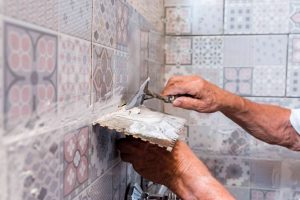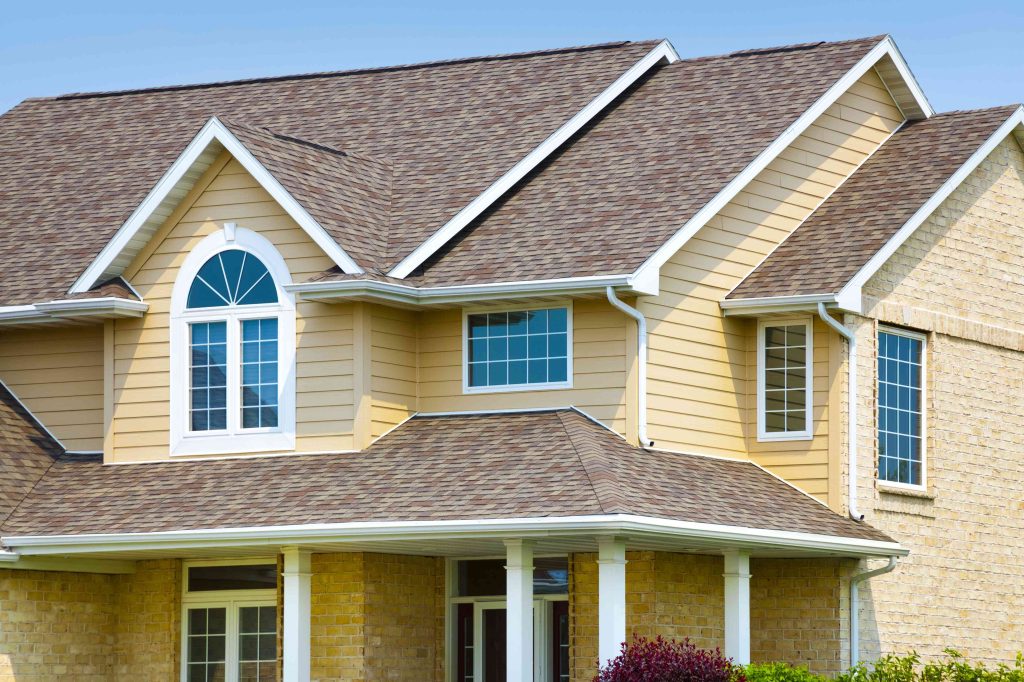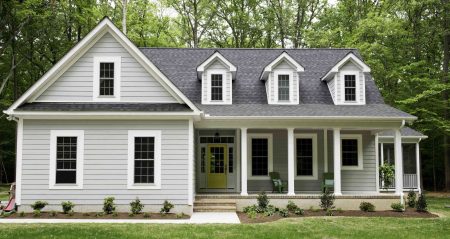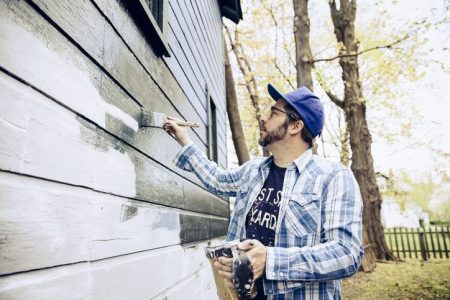Home siding material is the protective and decorative cladding that covers the exterior of a home or other building. Few home improvements or repairs can enhance the performance, curb appeal, and value of your house like new siding. Various siding materials have come and gone over the years, but a handful of standards have remained, along with the occasional newcomer. For example, no one uses asbestos siding anymore, and fiberglass and hardboard composite siding have been largely replaced with vinyl and a new standard, fiber cement. The four types of exterior siding for houses explored below include:
- Vinyl
- Wood
- Metal
- Fiber cement
When deciding on siding, you’ll find a range of colors, but the style of your house will influence what you choose. For example, classic colors look best on Colonial styles while pastels and brighter colors feel at home on Victorian houses. You’ll also want to consider your budget. Though vinyl is the cheapest and fiberboard is the most expensive, your house will benefit from the update. Siding also adds R-value to your home, which means the material can help improve the energy efficiency of your house. But not all siding has the same R-value, and it can be surprising to learn which materials have good and not-so-great R-values.
Here’s a more in-depth look at the cost of siding, features, and maintenance considerations of these popular materials, as well as the timeless options of wood and metal.
Comparing Siding Types
| Type | Durability | Cost Per 1,000 Square Feet | R-Value | Paintable |
| Vinyl | 10-30 years (depending on climate) | $3,000-$8000 (does not include insulated vinyl) | Regular: 0.61 Insulated: 2.0-4.0 | No |
| Wood | 15-40+ (depending on type of wood) | $3,000-$13,750 (varies per type of wood) | 0.81 | Yes |
| Metal | 30 years | Aluminum (uncoated): $3,000-$6,000 Steel (uncoated): $4,000-$8,000 |
0.61 | Yes |
| Fiber Cement | 50 years | $10,000 | 0.15 | Yes |
-
01
of 04Vinyl Siding
- Best for: Affordable siding that closely resembles wood.
Overview
As the search for low-cost, low-maintenance siding continued, the next evolution after aluminum and steel siding was the advent of vinyl siding. By the late 1960s, vinyl become widely available, and today, fully one-third of all homes in the United States are sided with some form of vinyl siding product—either horizontal lap siding planks or shake/shingle products. Vinyl comes in a range of styles, including horizontal and vertical panels, and an enormous range of colors and textures.
Installation
Commonly used as a retrofit siding, vinyl is often applied over old wood siding. When this type of siding is retrofitted to existing buildings there is generally a layer of fiber panels placed underneath the planks. This will add insulation to the walls. Proper installation is critical, or the siding will warp or buckle. Like aluminum, vinyl siding comes in strips with interlocking edges. A special tool called a zip tool is used to join and separate the siding strips.
Cost
While vinyl siding is considered the easiest siding to install, it is also known as the least expensive of the modern siding options. The national average for installing vinyl siding (materials plus labor) is $3 to $8 per square foot.
Pros-
Cheapest siding option
-
Very durable; some products warrantied for as much as 50 years
-
Never needs repainting
-
Professional installation is quick
Cons-
Can be prone to cracking in cold weather
-
When damaged, replacement of planks or panels is the only option
-
Repair materials can be difficult to find, as product lines are frequently discontinued
-
Susceptible to fire, heat damage
-
02
of 04Wood Siding
- Best for: Where a natural wood finish is desired.
Overview
Wood siding in the form of lap siding planks or shakes and shingles is a classic siding material and for centuries was the primary option where brick or stone was not a practical option. It remains one of the most attractive home siding options. Common types of wood siding include wood planks, boards or siding panels, and shingles. Wood clapboard lap siding is one of the oldest types of house siding, and you can see its beauty in many historic homes. The main drawbacks of wood siding are its high cost and relatively high maintenance needs.
Wood clapboard or beveled lap siding is horizontal and has overlapping joints that help shed water. Wood plank or board siding is vertical and comes in board and batten, board-on-board, and channel-groove or tongue-and-groove styles. Board siding also comes in a plywood version, often called T1-11, which is simply exterior plywood with various face treatments and groove patterns to emulate a traditional board-and-batten design.
Installation
Installation of wood siding is a fairly involved process, involving the application of a layer of insulated sheathing and a weatherproofing layer, then meticulous nailing of the planks or shakes to the house framing. This is not an especially complicated process—any skilled framing carpenter can do it—but it is time-consuming.
Cost
Wood siding costs run from moderate to very high. Nationally, average costs are $3 to $10 per square foot, installed, according to a major consumer cost estimating service. Cost varies widely by type of wood species and style of siding and exterior finish. T1-11 is the least expensive type, on average: $3.50 to $7.20 per square foot, installed. Cedar shingles/shakes are the most expensive, averaging $6.50 to $13.75 per square foot, installed.
Lap siding can run from about $2 per square foot for pine or cypress siding to as much as $14 per square foot for redwood. Cedar lap siding, the most common type, typically costs $5 to $10 per square foot, installed.
Pros-
Accepts many different stains, paint finishes
-
Provides a luxurious, authentic look; good for period restorations
-
Easy to change looks by repainting
-
Installation requires basic carpentry skills
Cons-
Requires regular maintenance; repainting or restaining
-
Can be prone to moisture damage
-
Relatively expensive siding option
-
Highly flammable; poor choice for regions prone to wildfire
-
03
of 04Metal Siding: Aluminum and Steel
- Best for: Affordable, durable siding.
Overview
In response to the high maintenance needs and dwindling supplies of quality wood suitable for siding, metal was among the first alternative siding materials offered, becoming popular in the 1950s. To this day, both aluminum and steel are commonly used to fabricate both lap siding planks and various shingle/shake style siding products. Aluminum siding was the first to fit the bill and it has evolved over the years into a very low-maintenance and popular siding choice for newer homes. In recent years, the availability of low-cost overseas steel has led to the emergence of steel siding.
Horizontal aluminum and steel siding comes in horizontal strips resembling wood lap siding, which include a mounting flange at the top for nailing, and an interlocking edge along the bottom to seal against the weather. It can be quite hard to distinguish metal siding from wood, especially at a distance. This siding typically includes a factory-applied finish for maximum corrosion resistance. Plain, unfinished steel panels are usually galvanized for corrosion protection. Some newer products have plastic or vinyl coatings that provide additional resistance to fading and weathering.
Installation
Metal is commonly used as “retrofit” siding, and it is sometimes applied directly over wood siding when the desire for low maintenance wins out over aesthetics or when the wood siding has been severely damaged. When this type of siding is retrofitted to existing buildings there is generally a layer of fiber panels placed underneath the planks to add insulation to the walls.
Cost
Uncoated steel and aluminum are moderate in cost. Average costs (materials plus installation) run $3 to $6 per square foot for aluminum and $4 to $8 per square foot for steel. Vinyl- or plastic-coated aluminum is more expensive. Material costs can fluctuate greatly depending on market conditions, tariffs, etc.
Pros-
Low-maintenance
-
Many styles available
-
Very durable—sometimes warrantied for as much as 35 years
-
Resists heat and fire
Cons-
Can be dented
-
Finishes on older products can fade, or get chalky
-
Can be noisy during hail or rain storms
-
Repainting requires careful preparation
-
04
of 04Fiber Cement Siding
- Best for: Premium appearance with low maintenance needs.
Overview
An increasingly popular siding option is fiber cement, a largely maintenance-free product that is fabricated from Portland cement and various natural cellulose wood fibers. Because it is made from recyclable materials, it’s resource-efficient. Fiber cement siding cuts and installs like wood siding. Some of the major manufacturers of this product include Allura, James Hardie Building Products (sometimes referred to as Hardie board siding), and Cemplank.
Fiber cement comes the closest to emulating a natural wood grain and is virtually indistinguishable from some wood siding products. It is available with a simple prime coat that you can paint to whatever color you want, or as fully finished pieces. Complementary trim and millwork pieces are also available to provide design detail for the home. It is available in beveled lap siding planks, shingles or shakes, or stucco-panel styles.
Installation
Fiber cement siding products are installed much the same way as standard wood siding—cut by ordinary carpentry tools and nailed to framing members over insulation and house wrap. Installation is somewhat more time-consuming than for vinyl siding, but the work is not difficult and almost any framing carpenter familiar with working with wood siding can easily install fiber cement siding.
Cost
Fiber cement is a moderately expensive siding option. The national average is about $10 per square foot, installed. While this is higher than vinyl or metal, fiber cement siding lasts a very long time, and you may never need to replace it over the time you own a home.
Pros-
Very long-lasting product; 50-year warranties are common
-
Resists damage from moisture, insects
-
Unaffected by heat and flame
Cons-
Fairly expensive siding option
-
Heavy materials; difficult for DIYers to install
-
Eventually requires repainting
Choosing a Siding Material
Almost any home can be sided with any of these four siding materials, so choosing the right one is mostly a matter of weighing your budget, your DIY aspirations, and your willingness to maintain the siding.
Natural wood siding is a good option when you want a truly genuine look. Other siding materials were developed as replacements for wood, so if the “real McCoy” is what you’re after, then true wood makes sense. If you are restoring a house to historical authenticity, for example, then you may well want to use natural wood. But be aware that natural wood requires a considerable amount of maintenance; you’ll be repainting or resealing every five years or so, and you’ll need to stay atop any water damage that develops. The reality is that for most homeowners who don’t need the authenticity of true wood, one of the other three siding options will be a better choice.
Fiber cement is a very good choice if you can afford it. This product is very hard to distinguish from real wood, but it will resist fire and heat damage and will require far less maintenance than natural wood siding. You may want to repaint it every 10 to 15 years, but that’s about it when it comes to upkeep.
For more budget-conscious homeowners, there are metal or vinyl siding products available, both of which are good durable choices for a siding material. Vinyl is the more affordable choice, while metal might be a better option if you live in a region where there is any danger of wildfire.
-
What is the cheapest siding for a house?
Vinyl siding is usually the cheapest siding option for a house.
-
What kind of siding is best?
The answer largely depends on your region. For example, metal siding, as well as fire-resistant fiber cement siding would be ideal for very dry climates. Wood siding may not always work best for extremely wet, rainy, and snowy regions. Vinyl can be great for homes in wet weather climates, but it’s vulnerable to problems, such as fading in sunny, dry regions or cracking in extremely cold temperatures.
-
What type of siding lasts the longest?
Of these four options, fiber cement board siding is usually the longest-lasting siding. However, if you choose the costlier redwood siding and maintain it well, that material could last well over 50 years.
-
How much siding do I need for a 2,000-square-foot house?
Siding is purchased in “squares.” Each square equals 100 square feet. So if you are buying siding for a 2,000-square-foot house, you would divide 2,000 by 100. that means you’ll need 20 squares of siding to complete a 2,000-square-foot house, plus a little more for gables and other architectural elements.
Read the full article here














